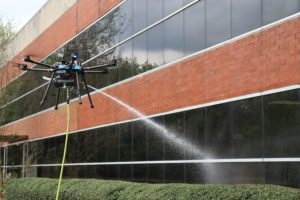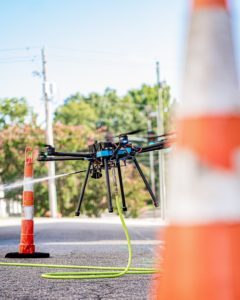 Company uses spraying drones to efficiently and safely wash buildings
Company uses spraying drones to efficiently and safely wash buildings
By Jim Magill
Innovative entrepreneurs continue to come up with new ways in which drones can be used to perform a wide range of jobs that had previously required human workers, more efficiently, at a lower cost and more safely, than was previously possible.
Continue reading below, or listen:
Charlotte, North Carolina Lucid Drone Technologies employs custom-built unmanned aerial vehicles to wash the exteriors of buildings, replacing the need of having workers get to tether themselves onto suspended platforms to perform that dangerous job.
Lucid CEO Andrew Ashur said the founders of the company discovered Lucid’s mission almost by accident.
“The problem really found us. We saw these window washers hanging off the side of a building, trying to clean from great heights,” he said. “It was a fairly windy day and we saw this platform just banging into the side of the building with the workers up there, white-knuckling the rails, and we just wanted to solve that problem.”
Lucid provides drones and equipment to customers across 18 states, from Florida to California. Its diverse customer base includes cleaning companies, college campuses and entrepreneurs who want to start their own high cash-flow cleaning business.
 Pooling the money they had raised through part-time jobs, the young founders of Lucid worked to develop a proof of concept for their fledgling business. In the summer of 2019, Lucid was among the handful of companies selected to participate in Y Combinator, an accelerator program for startups. Y Combinator, which had helped launch successful start-up companies such as Door Dash and Airbnb, provided advice and training in sales, fundraising and product development.
Pooling the money they had raised through part-time jobs, the young founders of Lucid worked to develop a proof of concept for their fledgling business. In the summer of 2019, Lucid was among the handful of companies selected to participate in Y Combinator, an accelerator program for startups. Y Combinator, which had helped launch successful start-up companies such as Door Dash and Airbnb, provided advice and training in sales, fundraising and product development.
“Even more importantly, it helps you build a great network because you’re in this room with a lot of other founders of other great companies and you’re going through similar problems, similar experiences,” said Ashur. “You just get to learn from one another and share that collective wisdom.”
In its operations, the company deploys hexa-copters specially designed to be attached to a hose hooked up to pumping equipment on the ground. The drone is able to carry a payload of more than 55 pounds, and when in operation can spray chemical cleaning agents onto the sides of buildings as high as 10 stories.
When fully unfolded, Lucid’s rugged but compact drones are about 53 inches in diameter and two feet tall. For transport and storage, they can be folded into a two-foot cube in about 30 seconds or so.
“What we’ve really focused on is making these drones simple and easy to fly,” Ashur said. “I’ve taught my 85-year-old grandmother how to fly the drone, so I promise anyone can learn it and you’d pick it up in no time.”
Pandemic impacts on company
The company’s initial start-up plans were almost derailed by the onset of the COVID-19 pandemic, which hit in early 2020, causing many workers to vacate their office buildings in favor of working from home.
“We were getting ready to launch the cleaning drone really the month that shutdowns took effect. We had to quickly pivot and figure out what product we could build in the middle of a global pandemic that would be useful to cleaning companies, because there weren’t a lot of people showing up to buildings anymore,” Ashur said.
The company’s leaders took Lucid’s core technology and built a drone capable of spray-disinfecting indoor stadiums. Lucid’s disinfecting drones were successfully used by big-name customers to disinfect stadiums owned by Texas A&M University and the Atlanta Falcons.
“But the joke we always told at Lucid is the disinfecting drone was a product we always wanted to go away. And sure enough, back in April of 2021, we were able to refocus on the cleaning drone and that’s all we’re focused on today,” Ashur said.
Custom-built drones
Initially company officials had planned to use off-the-shelf DJI drones with modifications to conduct the washing, but soon decided to design its own UAVs in order to meet Lucid’s unique operational requirements.
“Early on our thought was: let’s take the path of least resistance. Let’s go to a drone manufacturer and let’s build hardware and software around it that would allow us to clean buildings,” Ashur said. “What we quickly realized is that the DJI drones we bought weren’t technically capable of doing what we wanted them to do because they weren’t purpose-built for cleaning.”
In designing its drones for the specific purpose of cleaning buildings, Lucid first had to decide what cleaning method could best be adapted for UAV application. The company’s leaders decided the best cleaning technique involved spraying the building with a cleaning solution, a method that didn’t involve requiring the drone to ever have to be in physical contact with the building.
A second factor to take into account was the environment in which drones would have to operate. “Most drones fly in very open-air environments, such as when they’re inspecting a roof or mapping a plot of land, and that’s a pretty easy technical problem to solve. But our drones are flying very close to buildings where you’ve got high sources of interference,” Ashur said.
“So, another big design consideration for us is what sensors are we going to use that are more interference-resistant and how are we going to program these so that they all behave well with one another, so that we can fly in these more complicated areas where most drones can’t.”
Although Lucid’s building-washing drones are guided by a pilot their sophisticated software package helps them accomplish their mission. “We’ve got obstacle avoidance, high-end precision positioning,” Ashur said. “For us, the goal is to continue to increase that level of intelligence because our end goal is to make it so easy that the operator could show up on site and this drone could recognize its environment in real time and then self-optimize for the most efficient flight path.”
Soft washing vs. pressure washing
Lucid’s drones use a soft-washing technique, which sprays the cleaning solution chemicals against the side of the building at moderate pressure, at just a little bit greater pressure than that of a typical garden hose. This contrasts with high-pressure washing techniques that blast the sides of buildings with jets of liquid under between 5,000 psi and 10,000 psi of pressure.
High-pressure washing can damage many of the surfaces, such as limestone, brick and mortar that make up the façade of a building. In addition, in the case of mold stains, while pressure washing can remove the outer layer of mold, it doesn’t reach down to the roots of the mold inside the substrate of building material.
Soft washing, on the other hand “uses cleaning solutions to do the heavy lifting of the cleaning,” Ashur said. The specialty cleaning chemicals can kill the mold down to its roots, to permanently remove the stain.
“What we’ve really seen is a lot of people doing vertical surfaces have gravitated towards soft washing. Soft washing is oftentimes more time-affective than pressure washing because with pressure washing, you’ve really got to make sure you hit the stain head-on and hit every single square inch,” he said. With the drone-assisted soft-washing technique, a single pass can saturate the side of a building and remove all the stains.
Read more in-depth articles from Jim Magill:
 Jim Magill is a Houston-based writer with almost a quarter-century of experience covering technical and economic developments in the oil and gas industry. After retiring in December 2019 as a senior editor with S&P Global Platts, Jim began writing about emerging technologies, such as artificial intelligence, robots and drones, and the ways in which they’re contributing to our society. In addition to DroneLife, Jim is a contributor to Forbes.com and his work has appeared in the Houston Chronicle, U.S. News & World Report, and Unmanned Systems, a publication of the Association for Unmanned Vehicle Systems International.
Jim Magill is a Houston-based writer with almost a quarter-century of experience covering technical and economic developments in the oil and gas industry. After retiring in December 2019 as a senior editor with S&P Global Platts, Jim began writing about emerging technologies, such as artificial intelligence, robots and drones, and the ways in which they’re contributing to our society. In addition to DroneLife, Jim is a contributor to Forbes.com and his work has appeared in the Houston Chronicle, U.S. News & World Report, and Unmanned Systems, a publication of the Association for Unmanned Vehicle Systems International.
Miriam McNabb is the Editor-in-Chief of DRONELIFE and CEO of JobForDrones, a professional drone services marketplace, and a fascinated observer of the emerging drone industry and the regulatory environment for drones. Miriam has penned over 3,000 articles focused on the commercial drone space and is an international speaker and recognized figure in the industry. Miriam has a degree from the University of Chicago and over 20 years of experience in high tech sales and marketing for new technologies.
For drone industry consulting or writing, Email Miriam.
TWITTER:@spaldingbarker
Subscribe to DroneLife here.
https://dronelife.com/2022/09/05/hi-rise-window-washing-and-more-lucid-spraying-drones-solve-an-age-old-problem/
 Unmanned Aerial Vehicle The latest drone news
Unmanned Aerial Vehicle The latest drone news



